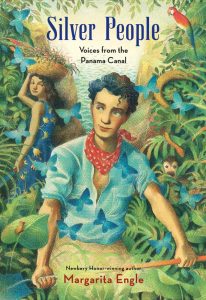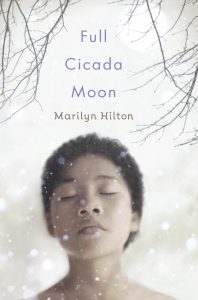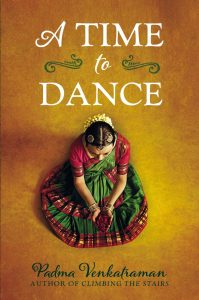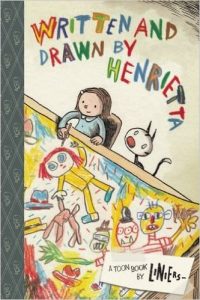Young People’s Inner Journey to Grow and Discover Their Agency
Michele Ebersole & Yoo Kyung Sung

Silver People: Voices from the Panama Canal by Margarita Engle
Michele:
This week’s book, Silver People, fits in perfectly with month’s theme. This story gives a historical account of the building of the Panama Canal through the voices of the “silver people” who do the dirty and dangerous work, a few of the “gold people” who are the privileged ones, and the animals, insects, and plants whose homes have been invaded. Through the different voices, the reader can come to understand the mistreatment, injustices, and suffering experienced by “silver people” who struggle to survive in deplorable conditions and imagine the perspectives of the animals, insects and plants in the natural environment.
Independent and anxious to find work, fourteen year old Mateo is lured from his Cuban home by Panama Canal recruiters who promise food, houses, and money. When he gets to Panama, hunger, discrimination, and loneliness cause him to regret his decision, but he knows there is no return. He meets Anita, an orphaned healer who is deeply connected with nature and the animals in the forest and Henry, from the island of Jamaica, who does the backbreaking and perilous work of a digger. Mateo also develops a friendship with Augusto, a Ph.D. geologist for the Americans, who helps see beyond his life situation.
Throughout the story these youngsters find themselves and their places in the world. They overcome the constraints imposed by their life circumstances. The meaningful relationships they develop and love they find in each other give them the strength to survive. In the beginning Mateo and Henry literally engage in boxing fights and later after saving Henry from a life threatening situation, Mateo states, “now all we crave is victory in our shared struggle to understand anything.” Throughout the story, Mateo is filled with hope for a better future and daydreams about possibilities. His curiosity, passion, and desire to know and learn more drive him. He says, “I feel certain I was born to learn” and fortunately Augusto is there to help him to develop his artistic skills and talents.
Each youngster finds the inner courage to move “beyond fences.” Henry walks off his job and integrates into a native village, Augusto abandons his contract and travels the world, and together Mateo and Anita create a life in Panama, finding love and peace with nature. The power of this story is that the characters find a way out of their undesirable circumstances and they are not framed by the situations that were placed upon them. They find the inner strength to make their own free choices.
Yoo Kyung:
Thank you, Michele for the thoughtful summary of the book. Your interpretation of young people’s inner strength and agency in Silver People are powerful. You looked at character’s relationship as opportunities for characters’ growth. I also read forced structural relationships as something each character can grow and strengthen their agency. Race and nationality construct the social basis for human interactions and life opportunity. Also Silver People challenges simplified Eurocentric concepts in multicultural Caribbean worlds. “Jamaica is one of Cuba’s closest neighbors, but this is the first time I have ever seen anyone from another Caribbean island. Until now, we have always been separated by the sea” (p. 14). The book mirrors currently prevalent social mindset when racial and heritage decide who to recruit and how much pay each race deserves as Gold people and Silver people signal. “No Cubanos, he shouts. No islanders, just pure Spanish, semi-blanco, semi-white, European. Civilized” (p.7). It may challenge audience’s social sensitivity and even fear for talking about racism through safe historical setting and place, Panama. When potentially problematic social structures are already set up by birth instead of something one can improve or control by effort, it is hard to be hopeful or to have a dream for changes. Silver People shows different perspectives through a range of diverse characters on how people survive with hope in the Panama Canal.

Full Cicada Moon by Marilyn Hilton
Michele:
When half Japanese, half Black Mimi moves across the country from California to Vermont, one of her seventh grade peers asks, “…What are you?” and she states, “It’s up to me to solve the puzzle of how to answer the question What am I? — When I know the real question begins with Who.”
At times we categorize or stereotype people based on external traits, or what we see on the outside. I enjoy this story because it is Mimi’s exploration and discovery of who she is rather than being molded or confined by others’ perception of what she is. Although Mimi faces obstacles and sometimes overt prejudices during her encounters with individuals who represent the social structure in that context in the 1960s (such as the soda jerk, Farmer Dell, her friend Stacy’s mother, the woman in Cottle’s, and David), her initial response is to react impulsively, yet she has the grit and willpower to resist reacting to the person’s behavior. Instead, she follows her father’s advice, “Be kind and respectful, and persist — like raindrops on granite, drip, drip, drip until the granite cracks.” This gives her the inner strength to persist and be patient with people. He tells her, “…raindrops are stronger than hammers.” This is another reason that I like the message in the story, change doesn’t always take place overnight and often we need to take “one small step.” It wasn’t a big courageous act that Mimi took to understand others and be understood, but rather taking small steps along the way. By drip, drip, drip slowly working, she makes changes, one step at a time. She comes to realize that she has the capacity to make choices and enact them on the world.
Yoo Kyung:
Thank you, Michele for the succinct summary and your insights. I agree that Mimi’s willpower to resist agreeing with discouraging social gaze is powerfully depicted in the story. Most of all, I want to support Mimi when she refuses to be the victim of people’s prejudice against what she believes right and wrong and what she dreams about for her future. Mimi may be perceived as tender and soft when she interacts with others, but she has a strong self-affirmation about who she is.
It is interesting to observe how California and Vermont differ, as when people in Vermont see Mimi as nobody. Mimi is somebody not nobody. Mimi is asked “what” she is instead of “who” she is by her peers at school. Mimi’s best friend can’t show Mimi’s father to her own family because he is black. Mimi’s interest in engineering confuses people. Mimi “is supposed to learn” domestic homey skills–women’s work. Mimi’s observation of people in Vermont, in terms of her gender and race, teaches us about cultures and social attitudes after all subsequent reflections of local history and regional experiences with people. That is exactly why we need culturally diverse books even if a community has low percentiles of ethnic and language diversity.
Local cultures should construct open-minded and readiness for diversity. Marilyn Hilton wisely uses different characters to illustrate regional shifts from California to Vermont in historical contexts. Just like Jackie Woodson’s The Other Side tells the danger of passivity of not having questions but following social practice in “it-has-always-been-this-way”, Full Cicada Moon challenges readers for our practices.

A Time to Dance by Padma Venkatraman
Michele:
A Time to Dance by Padma Venkatraman is distinct in comparison to the books that we read over the past few weeks. Although each young adult in the book’s inner journey to discover agency is unique, in this story, Veda experiences a traumatic life-altering event and she must find the strength to learn to live with her new situation. While she faces physical challenges, her spiritual and emotional journey is vital to her growth and empowerment.
What I appreciate about this story is how one can overcome challenges by seeing things in new ways. By nature, Veda is a fighter and faces her challenges with grit and determination; however, as a dancer with an amputated leg, she learns to be patient and faces the world with new eyes. In the story Veda asks, “Is God punishing us for sins we committed and bad Karma we built up in a past life?” Her grandmother explains, “To me, Karma isn’t about divine reward or retribution. Karma is about making wise choices to create a better future. It’s taking responsibility for your actions.”
All three books that we read this month show that we have a choice and can be defined by others’ perceptions or act upon our own agency. We encounter external forces (i.e., political, social, cultural) on a daily basis and these powerful stories give students an understanding of the ways that young people find inner agency. I also appreciate how these stories expose students to cultural practices and norms; however, through these stories students can connect with the universal experiences and emotions no matter where in the world one resides.
Yoo Kyung:
Among my recent personal readings, I don’t recall any story that depicts such dramatic changes in one’s life. Natural disaster and losing loved ones may be common themes. However, a story of dancer whose talent is already recognized and appreciated becoming “a disabled talent” from a car accident is a lot to take. Thanks, Michele, for your reminder of the positive side of the story that Veda’s determination and patience eventually recover her dancer identity despite her unexpected physical challenges.
I also want to address the commonality across stories we are reading this month. In a way, this book reminds me of Full Cicada Moon due to the gaze given to Veda. In Full Cicada Moon, Mimi’s bi-racial look earns uncomfortable gaze from a stranger/passenger in a bus and acquaint classmates in her school. People refuse to accept that the Japanese lady is Mimi’s mom because they do not “racially match”. In Time to Dance, Veda also gets a straight question, “what happened to your leg?” even before Veda herself makes sense of what happened to her leg and what it means for her life. Veda struggles with such glances and questions given by strangers.
On top of her physical challenges, being identified as “abnormal” adds extra hardship to Veda as does her prosthesis. She says, “My fake foot is cold, hard, senseless” (p. 104). The My Take books for this month illustrate social challenges in which characters’ life challenges grow harder. Additionally, the books strengthen the protagonists’ agency and their growth even though they are hard situations. Perhaps human beings cannot grow without challenges. Children’s books like this one, invite young readers to experience how to be courageous, not feeling defeat.
Venkatraman did a great job illustrating the details of movement before and after Veda gets her new leg. Such transitioning experiences are embedded in her detailed descriptions as Veda’s moves and feels while dancing. I also appreciate that the story is culturally responsive, yet portrays universal experiences. I read stories about children who have physical or mental challenges. However, characters in those books are often mainstream members. Global or multicultural literature with disability experiences is even harder to encounter. We need more children’s books that have universal experiences with culturally diverse responsiveness for young readers whose cultural backgrounds are all different.

Written and Drawn by Henrietta, A TOON Book by Liniers
Michele:
While this story belongs to a completely different genre than the other three novels told in verse, I enjoy the humor and childlike illustrations of this toon book. It shows us how we might pair very different types of books with similar conceptual themes for children to draw connections between them. For my first read, I had to search for connections to the theme and wondered how I might draw a connection.
To me, this toon book is about the power of choice, imagination, and a child’s capacity to create something new. The story begins with Henrietta receiving a box of colored pencils and she tells her cat, “A box of colored pencils is as close as you can get to owning a piece of the rainbow.” She realizes she has the ability to create, imagine, and dream of something new as she makes decisions in crafting her story.
It is evident that Henrietta does not think “inside the box” and is not defined by societies expectations; yet she understands the structure of story–a catchy title, action, plot, new ideas, real life elements, suspense, intertextual connections, involves research, secondary characters/helpers, and ends to wrap everything up.
Yoo Kyung:
I have learned that graphic novels are called “sequential art texts,” which includes comic books, graphic novels, manga, commix, etc. Perhaps sequential art texts are perfect invitations for young readers to think of themselves as writers, illustrators and even toon book-artists. The sequential process of creating story is visually and textually unpacked in this book. Various characters help Henrietta to think aloud to write a good story and it feels like those characters help readers to think aloud what an author needs for story writing (and drawing). Readers experience Henrietta’s “writing in progress.” Henrietta utilizes every possible resource she has. Books she had read before and her favorite stuffed animals are strong resources for her story creation. As you said, Michele, she knows important elements for writing a story from a catchy title to conclusive endings. These days, writing and reading are tied to “scary” consequences like assessments and tests. Some teachers report kindergarteners are now their “new first graders” in school. This toon book reminds young readers how writing a story is fun and exciting and empowers young readers with the idea that they can be an author too–like Henrietta.
